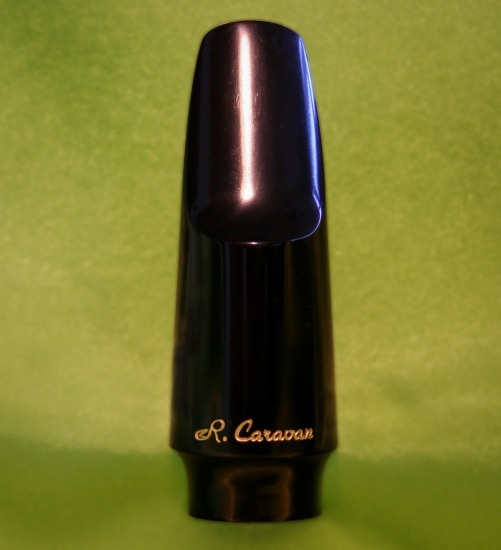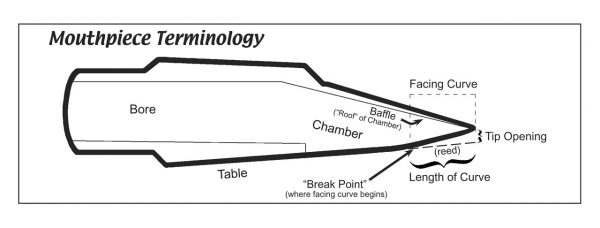Caravan C-Tenor („C-Melody“) Saxophon Mundstück
Eingeführt im Sommer 2014 in Reaktion auf mehrere Anfragen und Wünsche, die Caravan C-Tenor Saxophon Mundstück stellt eine moderne offene Kammer Mundstück produziert, um Vintage C-Tenor-Saxophone (allgemein als „C-Melody“ Saxophone bezeichnet) zu ergänzen. Tausende dieser Instrumente wurden vor 1930 in den USA hergestellt (die meisten in Elkhart, Indiana), und viele von ihnen werden auch heute noch in verschiedenen Bereichen verwendet. Obwohl der C-Tenor im Vergleich zu moderneren Es-Alt- und B-Tenor-Instrumenten oft mehr Probleme mit der Tonhöhe hat, erzeugt er einen einzigartig schönen Klang. Dieses neue C-Tenor-Mundstück ähnelt dem Caravan Bb-Tenor-Saxophon-Mundstück auf der Innenseite und hat im Wesentlichen die gleiche Stirnflächenkurve und Spitzenöffnung (etwa 0,067 Zoll), aber seine kürzere Länge und Bohrung sind so bemessen, dass sie für das C-Tenor geeignet sind. Dr. Caravan hat ein Conn C-Tenor-Saxophon (Seriennummer 132xxx) für die Entwicklung und Prüfung dieses Mundstücks verwendet.
Das Ronald Caravan Saxophon-Mundstück
Ronald L. Caravan: „Erhältlich für Sopran-, Alt-, Tenor- und Baritonsaxophone, stellt dieses Mundstück eine moderne Manifestation des ursprünglichen Mundstückdesigns von Adolphe Sax dar. Die Charakteristik der „offenen Kammer“ (keine Konstruktion in der Tonkammer) sorgt für eine beträchtliche klangliche Tiefe und eine dunkle Qualität für die „klassische“ Performance auf dem Saxophon, aber die Tonkammer ist auch so dimensioniert, dass sie im Vergleich zu älteren Open-Chamber-Designs viel Kraft und Fülle bietet. Der wunderbar ausgewogene Klang, den dieses Mundstück erzeugen kann, kommt in erster Linie von der tiefen Schallwand und der runden Tonkammer, die sich nahtlos in die Mundstückbohrung einfügt.
Dieses Saxophonmundstück wurde entwickelt, um es dem Saxophonisten zu erleichtern, eine Klangqualität zu erzeugen, die den Klängen entspricht, die man bei anderen Holzbläsern in der symphonischen und klassischen Musik in Amerika hört – ein „amerikanischer“ Klang, der mehr oder weniger eine Synthese verschiedener europäischer „Schulen“ darstellt. Der Klang, den dieses Mundstück begünstigt, ist eine besonders attraktive Alternative zu den helleren, „metallischen“ Klängen, die im Allgemeinen mit der französischen Schule und den Mundstückcharakteristika, die diese hervorbringen, assoziiert werden – ein Klangkonzept, das im Allgemeinen bei anderen Symphoniemusikern in diesem Land keinen Anklang findet.“
Caravan C-Tenor („C-Melody“) Saxophone Mouthpiece
Introduced in the summer of 2014 in response to multiple inquiries and requests, the Caravan C-Tenor Saxophone Mouthpiece represents a modern open-chamber mouthpiece produced to complement vintage C-tenor saxophones (commonly referred to as “C-melody” saxophones). Thousands of these instruments were produced in the U.S. (most in Elkhart, Indiana) prior to 1930, and many of them are still being used in various settings today. While often presenting more pitch problems to overcome compared with more modern Eb altos and Bb tenors, the C tenor produces a uniquely beautiful sound. This new C-tenor mouthpiece is similar to the Caravan Bb Tenor Saxophone Mouthpiece on the inside and has essentially the same facing curve and tip opening (around .067 in.), but its shorter length and bore are sized to be appropriate for the C-tenor. Dr. Caravan used a Conn C-tenor saxophone (serial no. 132xxx) in the design and testing of this mouthpiece.
The Ronald Caravan Saxophone Mouthpiece
Ronald L. Caravan: „Available for soprano, alto, tenor and baritone saxophones, this mouthpiece represents a modern manifestation of Adolphe Sax´s original mouthpiece design. The „open chamber“ characteristic (no construction in the tone chamber) provides for considerable tonal depth and darkness in quality for „classical“ performance on saxophone, but the tone chamber is also sized to allow for plenty of power and richness compared with older open-chamber designs. The beautifully balanced sound this mouthpiece can produce comes primarily from the deep baffle and round tone chamber that blends smoothly into the bore of the mouthpiece. Wider side and tip rails provide for greater purity in the tone and greater homogenity of color throughout the saxophone´s range.
This saxophone mouthpiece has been designed to make it easier for the saxophonist to produce a tone quality that corresponds appropriately to the sounds heard among other woodwind performers in symphonic and classical music in America – an „American“ sound representing, more or less, a syntesis of various European „schools.“ The sound this mouthpiece encourages is a particularly attractive alternative to the brighter, „brassier“ sounds generally associated with the French school and the mouthpiece characteristics that produce those results – a sound concept generally not found favour among other symphony musicians in this country.“


